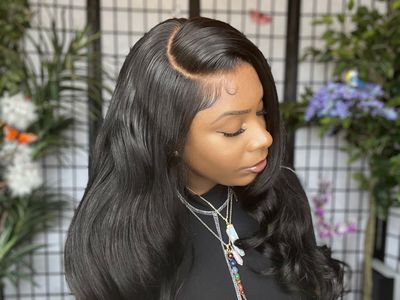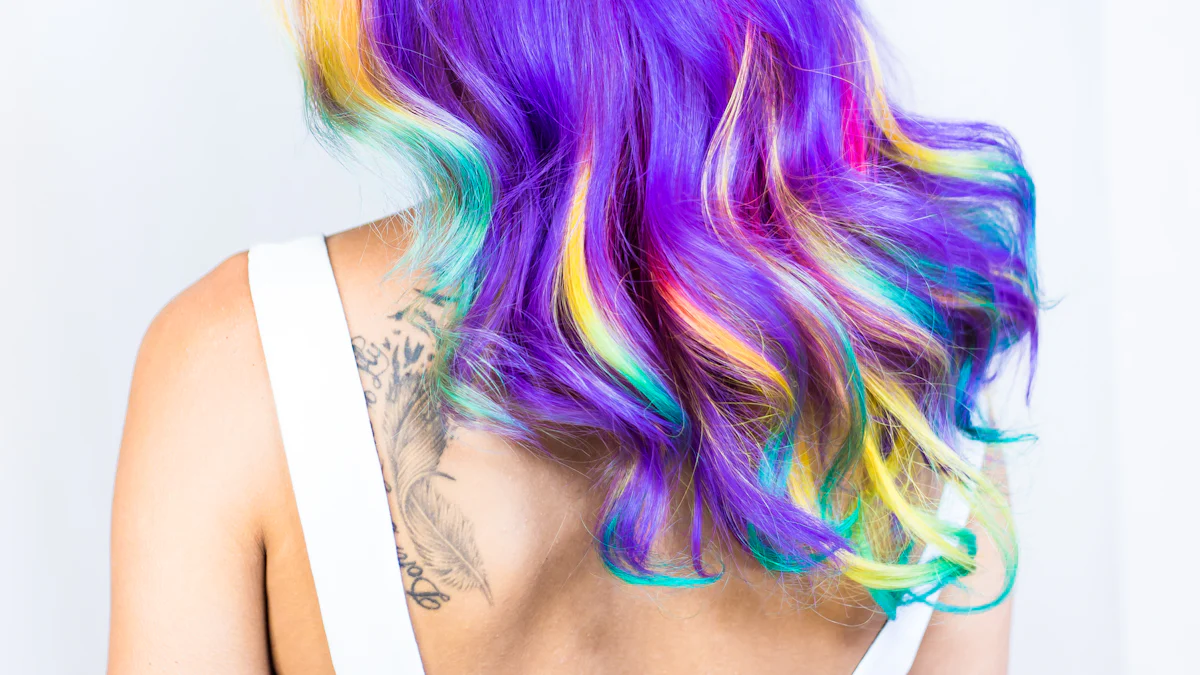A Comprehensive Guide to Choosing Colored Human Hair Wigs

Choosing the right wig type for coloring holds immense importance. The market for colored human hair wigs continues to grow, reflecting their popularity and benefits. These wigs offer versatility, a natural look, and a boost in confidence. This guide aims to provide comprehensive insights into selecting the perfect colored human hair wig.
Understanding Colored Human Hair Wigs
Types of Human Hair Wigs
Remy Hair Wigs
Remy hair wigs stand out for their high quality and natural appearance. The cuticles in Remy hair align in the same direction from root to tip. This alignment ensures smoothness and reduces tangling. Remy hair wigs offer a premium option due to their durability and ease of maintenance. Consumers often prefer Remy hair for its realistic look and longevity.
Non-Remy Hair Wigs
Non-Remy hair wigs present a more affordable alternative. These wigs are collected from multiple sources without attention to cuticle alignment. The cuticles in Non-Remy hair run in different directions, which can lead to tangling and matting. Despite these challenges, Non-Remy hair wigs provide a cost-effective solution for those seeking colored human hair wigs. Proper care can still achieve a satisfactory appearance.
Benefits of Colored Human Hair Wigs
Versatility
Colored human hair wigs offer unmatched versatility. Users can style, dye, and treat these wigs just like natural hair. This flexibility allows for various looks and styles, making them suitable for different occasions. The ability to change colors and styles enhances personal expression and creativity.
Natural Look and Feel
The natural look and feel of colored human hair wigs attract many users. These wigs mimic the texture and movement of real hair. High-quality wigs blend seamlessly with the wearer's scalp, providing a realistic appearance. The use of human hair ensures that the wig feels soft and natural to the touch.
Common Misconceptions
Durability Concerns
Many people believe that colored human hair wigs lack durability. However, with proper care, these wigs can last a long time. Regular maintenance and the use of appropriate products can extend the lifespan of the wig. Investing in high-quality wigs, such as Remy hair, further enhances durability.
Maintenance Myths
Another common misconception involves the maintenance of colored human hair wigs. Some think that these wigs require excessive upkeep. In reality, maintaining these wigs is straightforward with the right tools and products. Simple routines, such as gentle washing and conditioning, keep the wig in excellent condition. Proper storage also helps in preserving the wig's quality.
Factors to Consider When Choosing a Colored Wig

Hair Quality
Virgin vs. Processed Hair
Virgin hair wigs consist of hair that has never undergone chemical treatments. This type of hair retains its natural texture and strength. Virgin hair wigs offer superior quality and longevity. The natural state of the hair allows for various styling options without compromising integrity.
Processed hair wigs, on the other hand, have undergone chemical treatments such as dyeing or perming. These wigs may offer a wider range of colors and textures. However, processed hair can be more prone to damage and may require more maintenance. Choosing between virgin and processed hair depends on individual preferences and needs.
Hair Density and Thickness
Hair density refers to the number of hair strands per square inch on the wig. Higher density wigs provide a fuller look. Lower density wigs offer a more natural appearance. Thickness pertains to the diameter of individual hair strands. Thicker hair strands add volume and durability. Thinner strands create a softer, finer look. Selecting the right density and thickness ensures a wig that complements personal style and desired appearance.
Color Selection
Skin Tone Compatibility
Choosing a wig color that complements skin tone is crucial. Cool skin tones pair well with wig colors that have blue, violet, or ash undertones. Shades of blonde, brown, and black work best for cool undertones. Warm skin tones look better with wig colors that have red, orange, or golden undertones. Colors like auburn, honey blonde, and chestnut enhance warm undertones.
A wig color that contrasts slightly with skin tone can brighten overall appearance. Lighter tones can bring a youthful look. Matching wig color to skin tone creates a harmonious and flattering effect.
Personal Style and Preferences
Personal style plays a significant role in color selection. Some individuals prefer natural shades close to their original hair color. Others may opt for bold, vibrant colors for a dramatic change. Considering lifestyle and wardrobe can also guide color choice. A wig color that aligns with personal style enhances confidence and satisfaction.
Wig Cap Construction
Lace Front vs. Full Lace
Lace front wigs feature lace only at the front hairline. This construction allows for natural-looking hairlines and versatile parting options. Lace front wigs are easier to apply and more affordable.
Full lace wigs have lace throughout the entire cap. This design offers maximum versatility in styling. Full lace wigs can be parted anywhere and styled in updos. The full lace construction provides a more natural look but requires more skill to apply and maintain.
Cap Size and Fit
Choosing the correct cap size ensures comfort and security. Wig caps come in various sizes, typically small, medium, and large. Measuring head circumference helps determine the right size. A well-fitting cap prevents slippage and discomfort. Adjustable straps and combs within the cap can enhance fit and stability. Ensuring proper cap size and fit contributes to a seamless and comfortable wearing experience.
Tools and Accessories for Wig Maintenance
Essential Tools
Wig Stand
A wig stand serves as a crucial tool for maintaining the shape and style of a wig. Placing a wig on a stand helps it retain its form and prevents tangling. Wig stands also provide a convenient way to dry wigs after washing, ensuring proper airflow around the hair fibers.
Wide-Tooth Comb
A wide-tooth comb is essential for detangling wigs without causing damage. This type of comb minimizes breakage and helps maintain the integrity of the hair strands. Regular use of a wide-tooth comb keeps the wig looking smooth and tangle-free.
Recommended Products
Sulfate-Free Shampoo
Using a sulfate-free shampoo is vital for maintaining the quality of colored human hair wigs. Sulfates can strip natural oils and color from the hair, leading to dryness and fading. A sulfate-free formula gently cleanses the wig while preserving its vibrancy and texture.
Leave-In Conditioner
A leave-in conditioner provides continuous moisture and protection for wigs. Applying this product helps keep the hair soft, manageable, and free from frizz. The leave-in conditioner also adds a layer of protection against environmental factors, extending the life of the wig.
Additional Recommendations
Got2B Glued Blasting Freeze Spray: This styling product ensures that the wig stays in place and maintains the desired style throughout the day.
Moisturizing Shampoo: For human hair wigs, a moisturizing shampoo keeps the hair smooth and tangle-free, enhancing the overall appearance and feel.
Proper tools and products play a significant role in wig maintenance. Investing in high-quality accessories and following a consistent care routine will ensure that colored human hair wigs remain beautiful and long-lasting.
Tips for Maintaining Colored Human Hair Wigs

Washing and Conditioning
Frequency of Washing
Washing colored human hair wigs requires careful attention. Experts recommend washing wigs every 10 to 15 wears. Over-washing can strip the hair of its natural oils, leading to dryness. Under-washing can cause product buildup, affecting the wig's appearance.
Best Practices for Conditioning
Conditioning plays a vital role in maintaining wig quality. Use a deep conditioner after every wash. Apply the conditioner from mid-length to the ends, avoiding the roots. Leave the conditioner on for at least five minutes before rinsing thoroughly. This practice ensures the hair remains soft and manageable.
Styling and Heat Usage
Safe Heat Settings
Styling colored human hair wigs with heat tools demands caution. Set the temperature to a maximum of 350°F (175°C). Higher temperatures can damage the hair fibers. Always use a heat protectant spray before applying any heat. This step minimizes potential damage and maintains the wig's integrity.
Protective Styling Techniques
Protective styling techniques help extend the lifespan of wigs. Opt for styles that reduce tension on the hair, such as loose braids or buns. Avoid tight hairstyles that can cause breakage. Rotate between different styles to prevent stress on specific areas of the wig.
Storage and Care
Proper Storage Methods
Proper storage methods are crucial for preserving wig quality. Store wigs on a wig stand or mannequin head to maintain their shape. Cover the wig with a silk or satin scarf to protect it from dust. Keep the wig in a cool, dry place away from direct sunlight.
Avoiding Tangling and Shedding
Prevent tangling and shedding by following simple care routines. Gently detangle the wig with a wide-tooth comb before and after each wear. Start from the ends and work your way up to the roots. Avoid brushing the wig when it is wet, as this can cause breakage. Regularly trim the ends to prevent split ends and maintain a healthy appearance.
Choosing the right colored human hair wigs can transform one's appearance and boost confidence. Consider factors like hair quality, color selection, and cap construction to find the perfect match. Proper maintenance ensures longevity and a natural look. Regular washing, conditioning, and careful styling preserve the wig's beauty. Investing in high-quality wigs and following care tips will provide a satisfying and lasting experience.






















